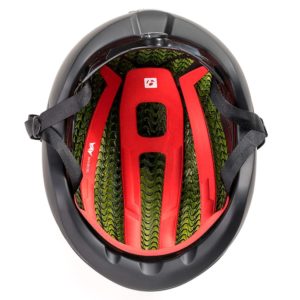There is a war of claims going on in the sports helmet world, and consumers might end up dazed and confused.

By Seth R. Lindberg, attorney at Burnett & Williams P.C., Loudoun, Fairfax, and Northern Virginia
As the weather warms, bikers of all stripes are getting out on the roads, and whether you’re inclined toward leisurely bike rides or you’re logging lots of intense training miles, you probably don’t need to be reminded that your most important piece of equipment is your helmet. As public awareness around concussions and traumatic brain injury has increased in recent years, so has the market for the newest, best, and safest helmet protection. And the companies who are at the forefront of these technologies are doing everything they can to corner the market, sometimes with confusing effect. So if you’re thinking about upgrading into the latest helmet-safety technology this spring, be aware that there are some potentially conflicting claims being made by competing helmet-manufacturers.

In a roll-out of the most recent product aimed at reducing what is known as Rotational TBI (a reference to the twisting motion understood to be the cause of most serious traumatic brain injuries), Trek unveiled its Bontrager WaveCel helmet, trumpeting it as “the most advanced helmet technology ever designed.” Trek asserts that WaveCel technology provides revolutionary concussion protection, claiming a rider wearing this new helmet is “up to 48 times less likely” to get a concussion than with a standard foam helmet. Great news, right? But Trek’s competition reacted unexpectedly, and confrontationally.
Sweden’s MIPS company has a lot at stake with the emergence of new — and potentially better — technology. That’s because WaveCell is a departure from MIPS, which is the established leading technology in the bike-helmet world. MIPS — which we wrote about last June and stands for Multi-directional Impact Protection System — isn’t just a technology, it’s also the name of the company that licenses the right to sell helmets that utilize its patented performance engineering.
The MIPS company promptly tested the WaveCel product in their own facility, and said they couldn’t replicate Trek’s claims, though their testing and analysis doesn’t appear to be entirely independent and unbiased. Trek, on the other hand, can’t claim that its own testing was completely free from bias, either — WaveCel technology is the work of Legacy Biomechanics Laboratory of Portland, Oregon, which also designed and led the product testing, while under an agreement with Trek, and on which Trek has based its claims. The report was published in the March issue of the peer-reviewed journal Accident Analysis and Prevention, and to its credit, while it clearly suggests WaveCell’s performance lead over MIPS, it also cautions the need for continued research and development.
The public argument about whose helmet technology keeps wearers safer from traumatic brain injury has threatened the reputation of both companies, with the optics of a brand turf-war overriding what’s best for consumers. We worry that whenever there’s doubt about which safety technology is actually superior, style and price will replace safety as the primary consideration when consumers go to buy a new helmet.
The really troubling aspect of all this, is it’s thrown a shroud of uncertainty over the safety ratings for all helmet products.
All of this highlights the need for better consumer protection in the form of independent testing, especially in industries that are largely self-regulated, and where people could be seriously injured as a result of dollar-driven — rather than safety-driven — messaging.
So what should you do if you’re in the market for a helmet?
The best advice for now is to ignore the chatter and, as so eloquently phrased by Joe Lindsey at Outside, “buy [a helmet] that Virginia Tech rates four stars or better and that fits you comfortably. Keep it clean, store it properly (inside your house, not the garage, and away from direct sunlight), and replace it every five to ten years.”
If, however, you wore a helmet during a bicycle crash, replace that helmet immediately. Bicycle helmets are designed to be “single use” safety devices. After a crash, the helmet’s foam and padding deform to prevent injury. After the helmet has been damaged, it cannot protect against another crash. Even if you were in a crash and the helmet appeared to remain intact, it is possible that foam and padding underneath the shell was compromised by the collision. The best course of action is to replace the helmet after any collision.
As we featured last June, Virginia Tech has shown a bright light on the confusing arena of helmet impact ratings, developing standardized systems and including evaluation for real life direct and oblique impacts. And wouldn’t you know, Trek’s Bontrager styles occupy the top three positions in VT’s helmet lab ratings: numbers 1 and 3 use Wavecel technology, and number 2 uses MIPS.
Hopefully in the end we’ll have safer heads…once they stop spinning.